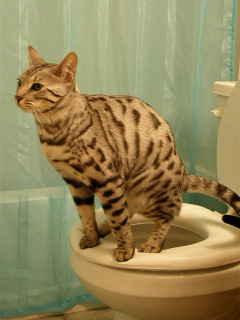Don't Flush Cat Poop Down Your Toilet - Preserve Your House's Plumbing System
Don't Flush Cat Poop Down Your Toilet - Preserve Your House's Plumbing System
Blog Article
Right here down the page you can find a bunch of professional content related to How to Dispose of Cat Poop and Litter Without Plastic Bags.

Introduction
As cat owners, it's vital to be mindful of exactly how we throw away our feline close friends' waste. While it may appear convenient to purge pet cat poop down the commode, this practice can have detrimental repercussions for both the atmosphere and human wellness.
Ecological Impact
Purging pet cat poop presents unsafe virus and parasites right into the water supply, positioning a significant danger to marine ecological communities. These impurities can negatively influence aquatic life and concession water quality.
Health and wellness Risks
In addition to environmental issues, purging cat waste can also present health and wellness threats to human beings. Feline feces may consist of Toxoplasma gondii, a bloodsucker that can create toxoplasmosis-- a possibly severe health problem, particularly for expecting women and individuals with weakened immune systems.
Alternatives to Flushing
The good news is, there are more secure and much more liable methods to take care of pet cat poop. Think about the following alternatives:
1. Scoop and Dispose in Trash
One of the most typical method of getting rid of pet cat poop is to scoop it right into a biodegradable bag and toss it in the garbage. Be sure to make use of a specialized litter inside story and throw away the waste quickly.
2. Usage Biodegradable Litter
Choose naturally degradable pet cat trash made from products such as corn or wheat. These clutters are eco-friendly and can be securely gotten rid of in the trash.
3. Hide in the Yard
If you have a yard, take into consideration burying pet cat waste in a designated area away from vegetable gardens and water sources. Make sure to dig deep sufficient to stop contamination of groundwater.
4. Install a Pet Waste Disposal System
Invest in a pet garbage disposal system especially made for feline waste. These systems make use of enzymes to break down the waste, decreasing odor and environmental effect.
Final thought
Liable pet dog ownership prolongs past offering food and sanctuary-- it additionally involves proper waste administration. By refraining from flushing feline poop down the commode and selecting different disposal approaches, we can reduce our environmental footprint and shield human health.
Why Can’t I Flush Cat Poop?
It Spreads a Parasite
Cats are frequently infected with a parasite called toxoplasma gondii. The parasite causes an infection called toxoplasmosis. It is usually harmless to cats. The parasite only uses cat poop as a host for its eggs. Otherwise, the cat’s immune system usually keeps the infection at low enough levels to maintain its own health. But it does not stop the develop of eggs. These eggs are tiny and surprisingly tough. They may survive for a year before they begin to grow. But that’s the problem.
Our wastewater system is not designed to deal with toxoplasmosis eggs. Instead, most eggs will flush from your toilet into sewers and wastewater management plants. After the sewage is treated for many other harmful things in it, it is typically released into local rivers, lakes, or oceans. Here, the toxoplasmosis eggs can find new hosts, including starfish, crabs, otters, and many other wildlife. For many, this is a significant risk to their health. Toxoplasmosis can also end up infecting water sources that are important for agriculture, which means our deer, pigs, and sheep can get infected too.
Is There Risk to Humans?
There can be a risk to human life from flushing cat poop down the toilet. If you do so, the parasites from your cat’s poop can end up in shellfish, game animals, or livestock. If this meat is then served raw or undercooked, the people who eat it can get sick.
In fact, according to the CDC, 40 million people in the United States are infected with toxoplasma gondii. They get it from exposure to infected seafood, or from some kind of cat poop contamination, like drinking from a stream that is contaminated or touching anything that has come into contact with cat poop. That includes just cleaning a cat litter box.
Most people who get infected with these parasites will not develop any symptoms. However, for pregnant women or for those with compromised immune systems, the parasite can cause severe health problems.
How to Handle Cat Poop
The best way to handle cat poop is actually to clean the box more often. The eggs that the parasite sheds will not become active until one to five days after the cat poops. That means that if you clean daily, you’re much less likely to come into direct contact with infectious eggs.
That said, always dispose of cat poop in the garbage and not down the toilet. Wash your hands before and after you clean the litter box, and bring the bag of poop right outside to your garbage bins.
https://trenchlesssolutionsusa.com/why-cant-i-flush-cat-poop/

Do you enjoy reading about How to Dispose of Cat Poop and Litter Without Plastic Bags? Write a short review further down. We will be pleased to know your thinking about this posting. We are looking forward that you come back again before long. Loved our entry? Please share it. Help another person find it. We truly appreciate reading our article about Don’t flush cat feces down the toilet.
Call Today Report this page